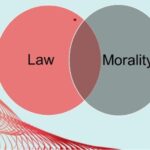Kids and Crime
Two recent articles about teen crime in Victoria make for disturbing reading. But of more concern is that most of the “experts” seem to have no idea what the real cause is. On August 1 the Herald Sun ran with this headline: “Teen crime soars” while on August 3 the Sunday Age had this headline, “Net blamed as 10,000 kids turn to crime”.
Both articles spoke of the huge increase in youth crime, and the concern of police and authorities. The first article said this: “The number of Children’s Court cases has soared alarmingly amid concern about child safety and worsening juvenile crime”. It said the “number of young defendants found guilty of an offence almost doubled from 5784 to 10,836 in the year to June 2007”. It also said that “Court president Judge Paul Grant is worried the court can’t keep up with demand caused by a spike in child protection applications, criminal cases and intervention orders.”
The other article also examined this worrying trend, and offered as a reason the Internet: “About 10,000 Victorian children aged 10 to 14 have been cautioned by police, arrested or ordered to appear in court in the past year, as a surge in youth crime continues. Victoria Police say the escalation in juvenile crimes – ranging from break and enters to drug offences and assaults – is being fuelled by children’s growing exposure to sexual and violent images on the internet.”
That youth crime is getting out of hand is undeniable. And it seems that the issue of Internet exposure is surely a contributing factor. I would not limit things just to the Internet, since prime time television is coming close to dishing up the same amount of trash.
Surely constant exposure to sexually explicit and violent and graphic content on the Net and in the rest of the media will have a negative impact. Young impressionable kids soaking up this stuff on a regular basis are of course going to be adversely affected by it.
But none of the newspaper accounts mentioned the real factor that is behind all this. I refer to family breakdown. The truth is, as more and more marriages and families break down, and more and more kids are not raised by their biological mother and father, such criminal activity will arise and worsen.
Now I can already hear my critics hyperventilating, so let me say what I am not saying here. I am not saying family breakdown is the only variable in the equation. There are many factors at work when kids go off the rails. And I am not saying that if a kid grows up in a broken, blended or single-parent family, he or she will automatically become involved in crime. And I am not saying that two-parent families produce perfect children.
Nor am I saying that families where one of the biological parents is missing do not need help and support. Single parents need all the help they can get. But what I am saying is what common sense, along with a wealth of social science data, already suggests: kids are much less likely to become involved in criminal behaviour if raised by a mother and father, preferably cemented by marriage.
That is the overwhelming conclusion of some forty years of research into this issue. Not only are kids who are raised by their biological mother and father much less likely to get involved in crime, but they are also much less likely to use drugs, commit suicide, do poorly in school, or engage in other anti-social behaviours.
Here is a small sampling of the evidence. One study of 522 teenage girls found that girls in divorced families committed more delinquent acts (e.g., drug use, larceny, skipping school) than their counterparts in intact families.
A study of street-gangs reveals this linkage as well. In a recent book on the subject, Francis Ianni found that most gang members in America come from female-headed households. And a study of British communities found a direct statistical link between single parenthood and virtually every major type of crime, including mugging, violence against strangers, car theft and burglary.
A study reported in Psychology Today found that “90 per cent of repeat adolescent firestarters live in a mother-only constellation”. A Michigan State University study of 72 adolescent murderers discovered that 75 per cent of them had divorced or never-married parents. And a study of 108 violent rapists, all repeat offenders, found that 60 per cent came from single-parent homes.
One study tracked every child born on the Hawaiian island of Kauai in 1955 for 30 years. It found that five out of six delinquents with an adult criminal record came from families where a parent – almost always the father – was absent.
An American author, reviewing the evidence, reports the following: “Poverty alone does not explain all of these effects. Indeed, poverty may not explain any of them”. He cites a 1988 study by Douglas Smith and G. R. Jarjoura which analysed victimisation data on over 11,000 individuals from three urban areas in New York, Florida and Missouri. They arrived at this startling conclusion: the proportion of single-parent households in a community predicts its rates of violent crime and burglary, but the community’s poverty level does not. Neither poverty nor race seem to account very much for the crime rate, compared to the proportion of single parent families, Smith and Jarjoura found.
In Australia, a book by Alan Tapper highlights this connection between broken families and crime. In a study of rising crime rates in Western Australia, Tapper suggests that “family breakdown in the form of divorce and separation is the main cause of the crime wave”.
A longitudinal study of 512 Australian children found that there are more offenders coming from families of cohabiting than married couples, and there are proportionally more offenders who become recidivists coming from families of cohabiting than married couples. The study concludes, “The relationship between cohabitation and delinquency is beyond contention: children of cohabiting couples are more likely to be found among offenders than children of married couples”.
Those who work with juvenile offenders in Australia confirm these findings. One youth worker in Melbourne has spent nearly two decades working with homeless youth and young offenders. He says that “almost 100 per cent” of these kids are from “single parent families or blended families”. And a recent New Zealand study found that 64.6 per cent of juvenile offenders had no birth father present.
The connections between crime and family breakdown have been made by the Centre for Independent Studies in Sydney, which compared crime rates with out-of-wedlock birth rates from 1903 to 1993. It found that the “percentage of ex-nuptial births correlates significantly with both serious and violent crime at both one and two decades time lapse”.
Drug usage is also higher among those who come from broken homes. An American study of over 1700 youths found that adolescents growing up in a single-parent or stepparent family often feel estranged and consequently drift into drug use and abuse. And a New Zealand study of nearly 1000 children observed over a period of 15 years found that children who have watched their parents separate are more likely to use illegal drugs than those whose parents stay together.
The truth is, until we get serious about family breakdown and the erosion of marriage, the trends in youth crime will not disappear, but only get worse. By all means, deal with other factors, such as the steady stream of toxic entertainment found in our media. But until the real cause of family disintegration is dealt with, we will simply see more criminal activity amongst our young people.
http://www.news.com.au/heraldsun/story/0,21985,24109878-661,00.html http://www.theage.com.au/national/net-blamed-as-10000-kids-turn-to-crime-20080802-3p00.html
[1283 words]




















I suspect that both family breakdown and instability and consumption of violent and pornographic media are both significant casual factors to this spike in violent and other crime among youth. And I think that family instability and breakdown and increased family pressures also contribute to increasing lapses of parenting re their children’s consumption of media. There is actually a lot of good research pointing to probable causal links between increased aggression and violent tendencies and consumption of violent media including interactive games. I think the spike in the crime stats might be more directly caused by the rapidly increasing game playing and violent content in media. Take “Heroes” as an example of what would have once been typical teen fare- except that the violence is horrific, explicit, constant and very graphic. Take the games such as GTA- celebrating random and extreme violence. Young people are spending large amounts of time on this kind of content and much more than a decade ago. Family dysfunction has been a continuous problem for several decades except that porn and violent media seem to be driving that dysfunction to new depths.
Angela Conway
Angela – you are spot on. Might I just add that the breakdown of marriage and the redefinition of ‘family’ have had an increasingly negative effect on today’s youth and children. We know that the marriage relationship is the cornerstone of a successful society because it is a framework given to us by God from the beginning. These types of statistics are, I feel, a welcome reminder to work hard at our own marriages, and to make a stand against the evil forces that would seek to dismantle God’s design and plan for family.
Ben Williams
I am appalled by the violent and explicit nature of today’s movies and computer games. I am equally horrified that many parents are oblivious to rubbish that their children are allowed to consume at a very young age. The popular media and Hollywood have a lot to answer for!
Peter Coventry
So how do we deal with the issue of family breakdown? It is a huge problem in our country, and has such depth involved that is often hidden under the surface. I just wonder how an issue like this can be either lowered and/or prevented? Does anyone have feedback on this idea?
Jesse Chatelier
Thanks Jesse
A whole article would be needed to answer your important question. (In fact some of my articles in the ‘Family’ section have dealt with this issue.) Various answers would have to cover the economic, political, legal, cultural and spiritual arenas. Here is a very quick and broad-brush reply:
Economically, more family-friendly tax policies and economic help would be part of this. There used to be a family wage in the old days, eg. Or various options can be canvassed such as income splitting, family unit taxation, etc.
Politically and legally, the various anti-family policies and bits of legislation need to be re-examined, such as no-fault divorce, special rights for homosexuals, and so on.
Culturally, there is much that pop culture has to answer for, with its promiscuous, anti-family messages, whether in TV, movies, girls’ magazine or music videos, etc.
Spiritually, this may be the most important. As society gets more and more secular, more and more selfishness abounds, and we only look after number one. A moral and spiritual reformation is also needed to turn things around.
But all this is detailed in some of my other articles. It is no easy task, and much prayer, thought and action is needed.
Bill Muehlenberg, CultureWatch
Thanks Bill for grounding your opinions in data from such a wide selection of formal studies. It is so difficult to get traction in an age of political correctness without such data. Yet almost every group (single parents, divorcees, defactos, same-sex couples, etc) seems so defensive in the face of even the most convincing evidence of social failure.
We live in the tragic social wake of the Lionel Murphy Family Law Reforms of the 70s and the inter-generational consolidation of the awful consequences of those ‘reforms’ that has still got some way to go, I fear.
It is interesting to note that in some areas of the social sciences, and certainly in the physical sciences, statistical variations/deviations of even a few percentage points are deemed significant to trigger policy reforms and political intervention. Yet, when it comes to those variations that speak critically into profound weaknesses in the social categories of political correctness, they are all too often dismissed or reasoned away.
I share your deep concern about our kids and many of the family-related statistics are certainly high on the list of disturbing correlations. Yet there are many other disturbing statistics that should also be the subject of serious investigation and protective intervention and/or rehabilitation. The statistical correlations coming out of our prison populations are an absolute indictment on a so-called ‘advanced’ western society. The statistics coming from the mental health sector are likewise alarming. The obesity and anorexia data are yet other indications that all is not well.
For me, the concern lies as much in the materialism-driven dual-income phenomenon that has gripped our society for two to three decades. We are so hooked on consumerism that time for and with our children suffers greatly and feeds into the cultures of unsupervised internet adventuring; desensitizing gaming with perverse and violent ‘playmates’ that no caring parent would ever permit if they were real; and unchecked freedoms to roam into the hands of the more predatory elements of our society.
The community of the playground has sadly become the standard-setter for kids in the absence of leadership and guidance from parents. All too often, parents are simply not there. So the shared ignorance, dysfunctionality and despair of the peer group becomes the source of comfort and guidance.
I long to see more large close-knit families in small functional homes, mixing in healthy communities, surviving on modest incomes with minimal media exposure and much less junk. Instead, we have the opposite. And it has a lot to answer for!
Bob Johnston
Jesse,
To Bill’s succinct reply, I would add this. The more of us who are committed to modelling and celebrating the powerful benefits of keeping family as our primary focus (after God), the more people will see that is attractive about commitment, fidelity, trust, intimacy, sacrifice, love, discipline and faithfulness.
I’m 35 years married and discovering new ways of loving my wife as I get older. I have four adult children who’ve been through their struggles and troubles, but every time they walk through the door (expected or otherwise) my heart skips a beat! I count it a privilege that they still value a hug, a cuddle, an intimate unpacking of the trials of life and an open declaration of their doubts and fears.
Is this just good fortune? I’d like to think otherwise. I remember the time we have invested together in making this possible and I remember the model of excellent parents who gave me something to emulate. To my great benefit, I have also been blessed by many excellent models with whom I have mixed in community. I have learnt much from watching them and adjusting my ways from the lessons learned. I have also enjoyed the discipline of listening to my wife’s observations and her wisdom.
I wish that were normative for everyone!
Bob Johnston
Thanks Bob
You mention the one item that I did not mention, and which may be the most important. In a world where marriages and families are falling apart all over the place, the example of a stable family and long-term marriage is vitally important. All of us in a marriage need to be the role model that others so desperately need. Thanks again for your wisdom.
Bill Muehlenberg, CultureWatch
Just 30 minutes before I read this, I made a complaint to my local grocery store; Woolworths because of a magazine revealing the upper half of a naked woman clearly displayed at eye level to a two year old! Oh yes, she WAS covered up slightly…..by the outstretched arm and hand of a man grabbing one of her breasts!
Of course, pornography is a concern for our vulnerable youth, and certainly, it is also a strong contributing factor to a percentage of marriage break ups and break downs. Double the trouble.
Annette Nestor, Perth